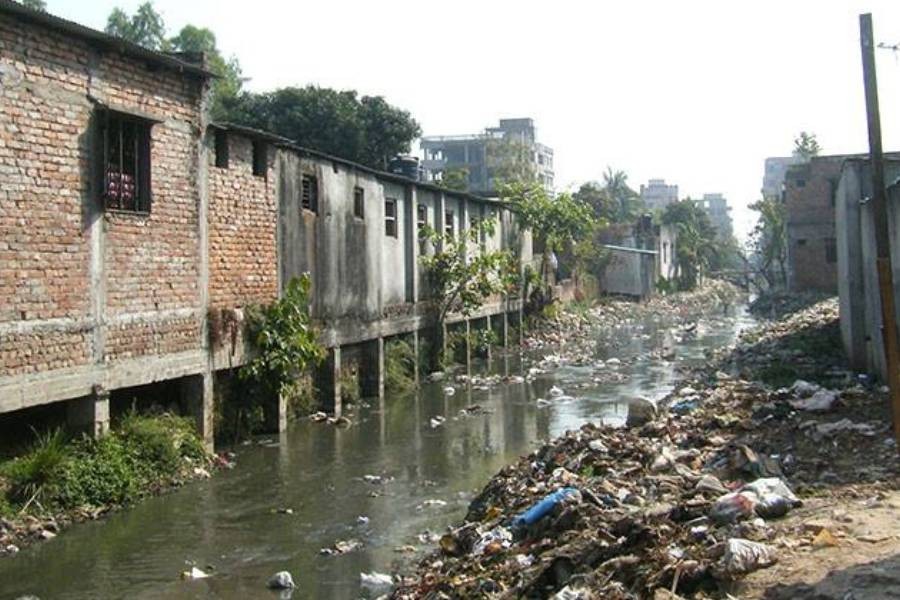Lamenting the loss of Dhaka's canals has for long been a subject of news stories --- not just as a manmade havoc on environment but more pathetically as a monstrous act causing water-logging and pollution of all sorts. It now appears difficult to say how many canals crisscrossed the capital once upon a time, and how many are still there.
The government has over the years carried out studies one after another, worked out master plans, even named some big land-grabbers and resolved to reclaim the occupied canals and lands. But nothing tangible has happened as agencies responsible for the management of the canals have themselves grabbed land, allowing private entities to step in, and remained silent about others occupying the canals and lands. There are a number of laws such the Canals Act 1864, the State Acquisition and Tenancy Act 1950, the Open Space and Wetland Conservation Act 2000 and the Bangladesh Environment Conservation (Amendment) Act 2010. Yet, the occupation and grabbing have continued.
Years ago, there was a move on the part of the concerned authorities to spend Tk 50.0 billion to excavate new canals in the northern part of the capital. While the project did sound holy enough to inspire hope of relieving some parts of Dhaka of the terrible water-logging during the monsoon, there was little or no action regarding the lost and dying canals. No matter how useful the new canals might prove to be, what bothers the country's urban experts is the authority's lack of interest in the lost and about-to-be-lost canals. We have been hearing about steps, even stern steps to address the situation from successive governments, but nothing is in sight as of now.
In the past 30 years or so, around 40 canals have either totally disappeared from Dhaka and areas surrounding them, while some have turned into tiny muddy trickles. A daily newspaper reports that 39 canals have totally disappeared. Those that are still alive are mostly in the grip of influential quarters. On the other hand, unplanned urbanisation has led to the building of box culverts over the canals, an act believed to be instrumental in killing the vital arteries of the capital.
The National River Conservation Commission has reportedly handed over to different agencies a report with a list of 77 canals and the nature of encroachment on them though the Dhaka Deputy Commissioner's office has been claiming for many years that the number of canals to be 54.
According to the Dhaka WASA, until 1985, the capital had 54 canals and most of those, interlinked as they were, flowed towards the four rivers around the city. It is not at all difficult to detect how most of them got lost or buried and the nature of hindrance that caused them so. All it takes, according to the experts, is political will.
In fact, it doesn't require an expert to bring home the importance of canals in rescuing Dhaka from the dreadful water logging and a host of other accompanying problems and public suffering. However, help from the experts is necessary to identify the routes of the canals lost to human greed and misdeeds. Professor Ainun Nishat, a noted environmentalist, in an interview with a local daily sometime ago, commented that tracing the routes of the canals can easily be done from documents, including the length and breadth of each and every canal. The Dhaka district administration can play a leading role in this. Most of the canals are 'owned' by the district authority. The Dhaka WASA is in charge of maintaining about two dozens of the canals, the remaining few are virtually 'orphans' with no single agency assigned to maintain them. Another renowned urban expert Professor Nazrul Islam commented that the only way to recover the lost canals and maintain them is through strict enforcement of law.
Besides grabbing of canals and nearby lands, building of box culverts on a number of important canals in the central part of the capital is considered by most urban experts thoughtless. These box culverts built on as many as twelve important canals with funding from the World Bank, Asian Development Bank and Japan International Cooperation Agency were made in 1989 allowing roads above them. But as it now appears, while undertaking the project the issue of maintaining clearance of channels under the culverts was not heeded to, which has now become a major concern due to blockage causing water-logging.
Canals in many big cities are lifelines potentially capable of cleansing cities from dirt and garbage in a natural way-- beside flashing out rain waters as well as containing flash floods to a great extent. In Thailand's capital Bangkok, canals encircling the city are also a treat for the eyes. The clean flow of water, courtesy of painstaking maintenance, is a good enough respite for the city dwellers away from the city's hustle and bustle.
In traffic-choked Dhaka, canals could also be an attractive means for an alternative mode of travel for commuters, provided that such a scheme is well designed and strictly enforced. But before indulging in such luxury, let the canals announce their presence first.


